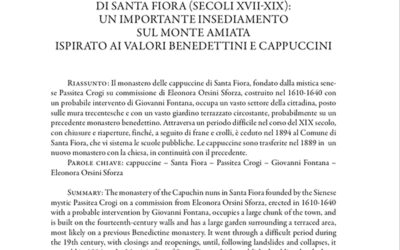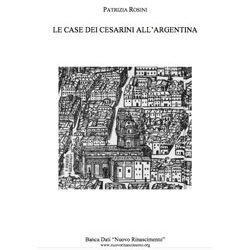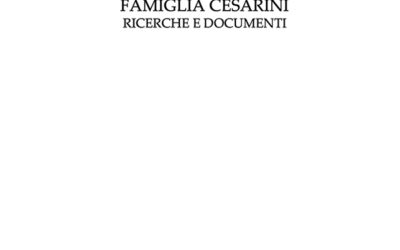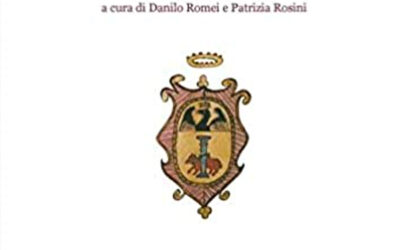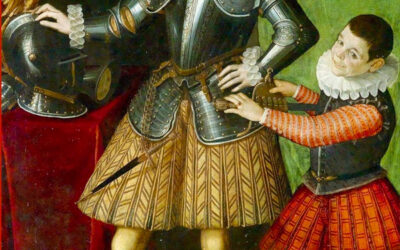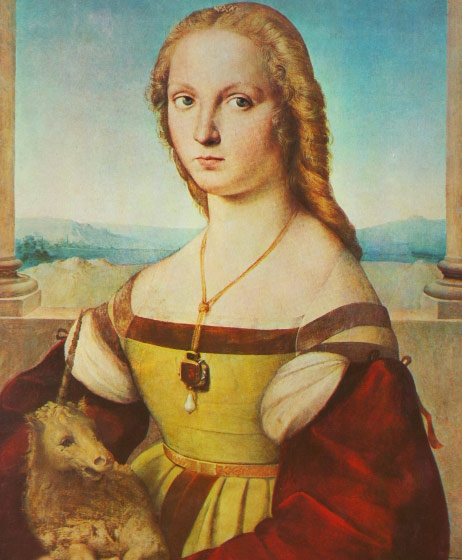
The story of the marriage of Giulia Farnese which took place in Palazzo Sforza Cesarini. Drawn from the book “Giulia Farnese, a woman slave of her own beauty” by Carlo Fornari, Silvia Editore, Parma, 1995, pages 62-63.
“The presentation of Giulia into society, if it can be defined such, took place on May 20 1489 in the star room of Palazzo Borgia in Parione [today Palazzo Sforza Cesarini]. That day, following the marriage agreements made many years before, the marriage preliminaries with the unfortunate Orsino Orsini were arranged […]. The star room was a very ample space on the noble floor of the palace utilized for the frequent ceremonies of the family, their friends, and for the high State authorities, the patrician Romans, the important personalities – that were worthy of being invited by one of the most illustrious families of the Eternal City. The room’s name derives from the frescos that decorated the ceiling and that depicted a clear blue sky strewn with golden stars: a sip of infinity, moreover, a frequent representation in the Medieval sacred and profane iconography. […] Other than the promised spouses, Cardinal Rodrigo Borgia, Bishop of Porto, Vice-Chancellor of the Holy Roman Church; Bartolomeo Martinez, Bishop of Segovia; Francesco Gacet, Canon of Toledo; and Giovanni Sraglia, Roman citizen, were present to the ceremony. […] The dowry of Giulia amounted to three thousand gold fiorini, a sum that placed the union at an excellent level in of the inevitable classification of the patrician families. Giulia’s brothers – Angelo and Alessandro – were guarantors of the payment together with the maternal uncles Giacomo Caetani , Apostolic Prothonotary, and Cola Caetani, both sons of Onorato and Caterina Orsini. The marriage took place the following year and was again celebrated in the apartments of the Borgia family on May 9 1490, in the presence of hundreds of guest as the chronicles refer.”.
Giulia Farnese (1475 – 1524)
Giulia Farnese was probably born in 1475 (maybe in Capidimonte) from Pier Luigi and Giovanella Caetani. The mother sent her to Rome at the age of fourteen to complete her education and with the specific purpose of finding the way to introduce the young girl into the Roman aristocracy, seeking the relevant privileges and concessions.
The chronicles of the time, recount that Giulia was very beautiful, maybe the most beautiful woman of the Renaissance. Also in view and recognition of this virtue, the Farnese house rose to a first level position in the history of that time. Unfortunately, there is hardly any information about her, not even a definite portrait of her: her elusive and “dishonored” figure is remembered only for her legendary beauty that, as mistress of Pope Alessandro VI Borgia, designated her the appellation of “ Sponsa Christi”.
During my historical research on the relationship between the Farnese and Caetani families and starting from an analysis of her testament, I had the opportunity to discover the figure of an “unpublished” woman, gifted with great intelligence, self control, generosity, respect and love for the others; qualities that had a fundamental role in her short life. “Knowing that in this fragile life our human nature, after the errors of the first distant men, is subdued to death […]”, this is one of the phrases that initiate Giulia’s testament, written on March 14 1524 “in Rome in the Arenula district, in the room of the testatrix viewing the church of San Girolamo […]”. Giulia is by now a mature woman who recognizes her own mistakes thanks to which shewas reborn as the legendary “Phoenix” which she has included among the fresco images in her castle in Carbognano.
She lived in the magnificence of court, madly loved by a pope who gave her not few economic advantages, in fact, she was one of the richest and powerful women of the time. As Lorenzo Pucci wrote in January 1494: “ she has an intent goldsmith that makes rings for one thousand ducati […] and the poor Cardinal [the brother Alessandro Farnese] does not have to live “, to the point that he suffocates in debts (Picotti 1928).
Giulia was able to obtain the Cardinalship for her brother Alessandro and she was also his financial sustainer. A voice, taken from the Sanudo (Diarii I, Venezia 1879) in February 1498, relates: “ Madame Julia’s brother, being a poor Cardinal, seemed inclined to refuse the hat” and as Zapperi believes: “according to a fiscal review from the Apostolic Chamber in the autumn of 1500, his annual income was very low, only 2,000 Ducati, and placed him among the poorest members of the Sacred College. As such, it is difficult to understand how he could buy, on January 30 1495, the Roman palace of Cardinal Pietro Ferriz, the first base of the future Palazzo Farnese, for the conspicuous sum of 5,500 Ducati. Certainly, not with the earnings from the Patrimony Legation (the first salary of 100 Ducati was paid to him on November 18 1494)”.
One can reasonably believe that the acquisition was possible thanks to the generosity of his sister Giulia, who, as already evidenced, had significant economic possibilities. Giulia had the possibility of being a free and independent woman once the important relationships with Pope Borgia (who died in 1503) and her unfortunate husband Orso Orsini (who died prematurely in 1500) ended. Shortly after, she saw the so desired marriage (November 1505) of her daughter Laura with the nephew of Pope Giulio II Della Rovere, which caused the disbursement of 30,000 ducati in addition to jewels, precious fabrics and furniture (Piccotti 1928).
After these events, Giulia lived between Carbognano and Rome, where she owned a house next to Palazzo Farnese in the Arenula district and which she gave to her daughter in 1512. Giulia’s testament evidences her personality and the type of life she lived in the second part of her existence, a period in which she was free and no longer subdued to passions and intrigues.
After the instructions for the construction of a chapel in the church of Santa Maria in Carbognano and for the acquisition of a painting of the Virgin Mary, to be placed in the chapel, and of the sacred objects for the chapel, as well as, the directive for the bequeath of monies for the acquisition of farmlands in Carbognano, for the sustainment of the Church and the Chaplain, the testament continues with the instructions for the women that served her with affection. In particular, Giulia was keen to leave:
- Two hundred carlini ducati for the marriage of poor and honest young women of Carbognano (chosen by her servant and friend Honofria of Spoleto, a Franciscan tertiary);
- One hundred ducati (in addition to the preceding) to marry poor and honest girls and for the sustainment of poor people;
- Eighty fiorini to Berna di Carbognano, her maidservant, inclusive of “all the other things that according to custom and practice of Carbognano is common for young brides”; in the event Berna did not marry, the bequeath had to be respected for her “good service”;
- Eighty fiorini to Aurelia and Rosa of Carbognano as dowry for their marriage which had to be disbursed “even if they did not marry” and in the event the ladies did not have legitimate of natural children, they were obliged to leave the dowry to charity. They were also free to decide, without any constriction from any one, to remain or not at the service of the heir, Laura, her daughter;
- Forty carlini ducati for Honofria, immediately after her death, to integrate the one hundred that had been given to her some time before in relation to her services and for the dowry promised to her;
- The use of the house she had built in Carbognano and a piece of land nearby to make a vineyard, was to be given to Honofria and her sister Orsolina with the right to transmit the use of these assets to their grandchildren Mario or Luca who, however, would then have to pay taxes to the Curia of Carbognano;
- Honofria was totally exempted from reporting her activities as administrator and the gains she produced since: “ […] she has always been loyal in administrating. Hence, nothing must be required from her” and she was also allowed to freely enter into the land possessions of the deceased in the area of Carbognano and to pick all the fruits she desired;
- Honofria is also entitled to receive a mattress and a blanket as well as sheets, table cloths, and towels. Wheat, wine and pork in addition to six ducati per year as well as any disbursements needed in the event of future illness;
- Fourteen ducati to Orsolina, maid of the deceased;
- Forty ducati to Lucia, servant of the deceased, in addition to the house and land in Bassanello that she had already received as dowry. In the event she remained a widow, she would be entitled to wine, wheat and six ducati each year until her death. To her husband Camillo from Viterbo, she left one hundred carlini ducati with which he had to buy stable possessions in Bassanello or anywhere he wanted to be inherited by the children he and Lucia had;
- Ten ducati for Agnese from Ischia, her nurturer, asking her daughter Laura, sole heir, to sustain her with housing and clothing and seven ducati per year, and to treat her with humanity and charity as she had done. Moreover, she leaves Agnese thirty ducati that she can benefit from for life but is due to leave to her nephew Pompeo. Lastly, she gives Agnese the liberty to decide if she wants to live with Laura and if so, adds other goods that must be given to her annually in the form of food;
- Twenty-five fiorini to her servant Diomede and to Father Giovanni from Carbognano who served her; twenty fiorini to Leandro Rogazio so that he can buy a piece of land in Carbognano, twenty fiorini to Girolamo Robertescchi from Orte for the services he rendered;
- Five hundred sheep and a black taffeta vest to her niece Isabella, daughter of her sister;
- Fifty sows, fifty goats, eight steers to sow the land and a black velvet vest to her niece Costanza, daughter of her brother Cardinal Alessandro Farnese;
- To her brother, Cardinal Alessandro, she left a bed, mattresses and various bed linens chosen by the loyal Honofria;
- All the other assets were left in inheritance to her daughter Laura asking her and her heirs to provide housing and food to seven poor people of Carbognano to be distributed by Honofria and subsequently by the heirs of the testatrix;
- Seventy-five gold ducati to the churches of Santa Maria degli Angeli and Virgin Mary, because of a vow she made.
I would like to note, that Giulia had her will written just a few days before her death, in March 1524, an era in which women did not have much choice other than submit themselves to men and live in ignorance; an era in which it was not possible to dispose of dotal property nor to administer the economy of one’s family. In the will, we find Giulia’s great generosity and her kindness for women. Her concern was to provide economic security to those who had accompanied her all her life. To Honofria, housekeeper and loving friend, she endows money and assistance in addition to renewing her role as administrator of Carbognano without the impediment of anyone. She thinks of her dear nurturer Agnese and entrusts her to her daughter Laura, reminding her to treat her with humanity and care. She affectionately recalls also the young poor women of Carbognano, who had known her as the good woman who had appreciated their honest service as servants, ensuring to some of them an endowment that gave them the freedom to dispose of the money even if they did not marry! We can therefore affirm that hers is a feminine will.
Hence, we find that Giulia is a “sovereign” and “mother”, she does not only think about leaving money but rather, she tries to ensure a serene future to her women by instructing in detail the delivery of food and asking her own future descendants to provide perpetually housing for the poor of Carbognano. It is, in other words, the portrait of a woman who was able to metabolize the power she received and at the same time to “purify” herself of the Palace hypocrisies. She, a young girl of fourteen, thrown into the arms of a powerful and elderly Cardinal, envied for the wealth that derived from her role as papal mistress, used by her mother, her mother in law, and her brother Alessandro, was able to accomplish an internal and external “catharsis”. She never folded herself to the role of a subdued woman, on the other hand, it was she who facilitated the transformation of the Farnese family from simple provincial noblemen to lords and princes of the Renaissance, identifying herself with the family emblem: the unicorn to which she associated the image of a young dame, which we can still admire in the rooms of her Castle in Carbognano.The Fortress of Carbognano, Castle of Carbognano (VT)
(photograph taken from the site: http://www.comune.carbognano.vt.it)
Young girl living water to the unicorn – Rocca di Carbognano
Moreover, Giulia was able to abandon her role of papal mistress and to maintain her role of noble dame. When the Borgia fell in disgrace after the death of Pope Alessandro VI (August 1503), she already had another life. She remarried in Naples in 1506 a Neapolitan nobleman, Giovanni Capece Bozzato, who had arrived to Rome a few years earlier as part of the court that followed Princess Sancia D’Aragona. Rumors of the time remember this man as a character loved by women of the court because it seems he had great amorous qualities. Giulia, however and irrespective of the rumors, married him for love, unfortunately it ended very soon, in 1517, in fact, she became a widow for the second time.
Giulia died in her house next to Palazzo Farnese, circled by priests from the Confraternita di San Girolamo della Carità who resided in the anonymous church that she could see from the window of her bedroom. I am convinced that she was buried in this church, contrary to the request she left in her testament which was to transport her body to the church in the island of Bisentina where “[…] her progenitors and ancestors were buried”. When Giulia died, for reasons unknown to us, the plague had begun to invaded Rome making it very difficult, hence improbable , to transport the body to the distant Island of Bisentina.
Castel Ruspoli Marescotti – Vignanello (VT)
(photography P. Rosini)
Chapel of Ortensia Farnese Sforza Marescotti
Chiesa di San Girolamo della Carità di Roma (photography P. Rosini)
Today in the afore mentioned church of San Girolamo, we find the chapel of a Farnese dame: it is the one acquired by her niece, Ortensia Sforza Marescotti (daughter of Antonio Bagliono, Lord of Castel di Piero, and Beatrice Farnese Lords of Latera (+1583), heir of the feuds of Vignanello and Parrano) and where she was buried (1584) next to her son Alfonso Sforza Marescotti (1606).
It is helpful to mention now that Bartolomeo Farnese, brother of Giulia, began the branch of Latera (VT) and hence Ortensia was among the nieces that Pope Paolo III protected for life. Ortensia in particular had a very hectic life, numerous husbands, children and never ending economic problems. Various of her letters are kept in the Archive of Parma, they contain recommendations, prayers and requests for protection made to the Pope and then to Cardinal Alessandro Jr.; they provide a very clear indication of the affection and union that the Farnese had among them. Ortensia was always called by her mother’s last name and never “Baglioni”, a sign that the protection the family provided to this very unfortunate Farnese was very strong. We do not know why Ortensia chose the church to which Giulia was particularly tied, but it is possible that in the church lay the tomb of her an ancestor ; this was another reason to ask Cardinal Alessandro Jr. to intercede with the priests of La Carità so that they could grant the authorization to build her family Chapel.
Felice Della Rovere
portrait by Raffaello Sanzio
taken from the site: www.carlottersen.net/Project-01%20Felice/Preface.htm
Papa Giulio II Della Rovere
Raffaello Sanzio, London National Gallery
taken from the site: http://commons.wikimedia.org/wiki/Image:09julius.jpg?uselang=it
The story of the marriage of Felice Della Rovere, daughter of Pope Giulio II, which took place in palazzo Sforza Cesarini. Drawn from the book by Caroline P. Murphy “La figlia del papa, Il Saggiatore”, Milan, 2007, pages 100-104.
“The wedding of Felice Della Rovere was held between May 24 and 25 1506. Giulio II issued a public order that baned any public celebration of the event: “The Pope did not want to make any demonstrations, being her daughter, as had Pope Alexandro”, wrote Sanuto. The marriage ceremony did not take place in the Palazzo Vaticano but in the palace owned by the cousin of Felice, Galeotto Franciotto Della Rovere, Cardinal of San Pietro in Vincoli, who had participated to the negotiations regarding the transfer of Felice’s dowry to Gian Giordano. The palace, known at the time as the Cancelleria and today as Palazzo Sforza Cesarini, was built in 1458 by Rodrigo Borgia, enemy of the Della Rovere, when he was still a cardinal. The Della Rovere family took possession of it to delimit its own territory on the opposite side of the river in respect of Palazzo Vaticano. Giulio would soon order the construction of a road next to the palace, called Via Giulia, which according to the antique criteria was built straight as an arrow, in net contrast with the knot of small street in the medieval city.
Hence, Felice was married in an environment close to her family, but the Cancelleria was rather distant from Palazzo Vaticano where the weddings of all her cousins had been held. Moreover, Giulio, whose name never appears in the approval of the dowry, was visibly absent in the ceremony. Paride Grassi, meticulous master of ceremonies at the Palazzo Vaticano, was in charge of the organization and wrote a long report of the events and happenings.
Many aspects of the event were without doubt unpleasant for him. He described the union as “ dually bigamous” referring to the fact bothe Felice and Gian Giordano had been married before, and he declared himself doubtful in respect of the fact that the union should receive an official ecclesiastical benediction. The wedding took place in two phases: the first, on Sunday, consisted in an announcement of the terms of the marriage. No women participated to this ceremony, including Felice herself who was represented by her cousin Galeotto Franciotto Della Rovere. Among those present, there were twelve cardinals, eleven of which, Paride Grassi noted, wore red hats, whilst one, Giovanni de’ Medici, the future Pope Leone X, had chosen to wear a purple one. Giovanni de’ Medici was Orsini from the side of his mother Clarice, hence he probably felt entitled to distinguish himself from the others. “[…] the uncle of Felice, Giovanni Della Rovere, prefect of Rome, as well as the French, Spanish and Imperial ambassadors, in addition to many members of the Orsini family, were present.”
This first part of the ceremony was held in the living room of the Cancelleria. Paride Grassi had prepared a room with carpets, twelve arm chairs for the prelates and a chair with a velvet cushion for the prefect. The other guests sat on long benches covered in leather and placed on the four sides of the room. Two notaries were present, Mister Tancredi from the Apostolic Chamber for the bride and for the groom, Prospero d’Acquasparta, who announced the amount of Felice’s dowry and the terms of the concession. Whilst the formalities were performed, Gian Giordano did not stay seated but went to greet his new family, Galeotto and Giovanni Della Rovere.
The following day, the actual wedding was celebrated. Paride Grassi refers that Gian Giordano Orsini did not want to attain himself to the Roman traditions and followed the French and Spanish ones. For superstitious reasons, the husband requested that the wedding rings not be shown but rather be placed on their fingers directly by the celebrant, his cousin Rinaldo Orsini, Archbishop of Florence. Later, Paride Grassi noted that the rings were very simple and worth less a few ducati. Although the ceremony should have begun punctually at four , at the last minute, due to astrological responses, Gian Giordano insisted that it be delayed until seven, and Felice was obliged to wait sitting in the chapel for three hours. In the mean time, the groom arrived to the Cancelleria, “not in his wedding outfit but wearing his hunting attire, with leather boots, a hat, unshaved beard, uncombed hair and with a baleful appearance.” He took advantage of the delay to call a barber and dress himself more appropriately, with a velvet tunic, a hat and a golden chain. Grassi does not describe the dress of the bride, nor does he specify if she wore jewelry, which means that she was probably dressed in a very somber manner.
Gian Giordano introduced many diverse elements to the ceremony, unexpected to both his wife and the participants. At a certain point, he took out a handkerchief and gave it to the celebrant, explaining him that he should give it to his wife who, evidently, did not know what to do with it; and this was not the only embarrassing moment for the poor Felice: following the exchange of the rings and the vows, and after the spouses had been declared husband and wife, Gian Giordano turned towards her and gave her what Paride Grassi calls in Latin osculo galico, a French kiss, “in other words” he wrote “a kiss biting her lips with his mouth, which made her blush and provoked marvel and laughs among many participants”. After the osculo galico, Gian Giordano and Felice immediately consummated the marriage in the bedroom of Cardinal Galeotto Della Rovere, undoubtedly decorated with opulence. This practice ensured that neither side could try to annul the marriage sustaining that it had not been consummated. At least, they were relieved from witnesses, given that Paride Grassi underlines that none of the guest were present. This did not impede those that were outside the room to makes imagine what was happening inside. Emilia Pia, in a summary sent to Isabella d’Este, declares that “Zordano took the spouse and placed her in a room and there they stayed a quarter of an hour and […] many thought that they did other secrets”, referring to the exotic and unexpected French kiss.
After this brief act of sexual union, the marital banquet was moved to Monte Giordano […]. Emilia Pia offers a direct summary of what happened after the guests left the Cancelleria. On its way from the Cancelleria to Monte Giordano, it would have been more appropriate and respectful if the procession passed through Via Papalis, the central artery that connect the two palaces . Instead, it walked through an anonymous small street, Via del Pozzo Bianco,, which takes its name from a white marble sarcophagus used as a fountain of potable water. The walk was short but very inconvenient. Emilia Pia wrote: “He wanted to pass by a street called Pozo Bianco where women of bad reputation stand , also in this case so much was said that he took another street and the women that were with Madame Felice were Madame Julia [Farnese, mother of Laura Orsini, the new wife of Niccolò, cousin of Felice[ and the daughter and sister of San Pietro ad Vincula : and Madame Julia turned and said that certainly the husband did not have to do much to be a gentleman had he not done what he did in that small street: and since they were close to Monte Zordano confetti were thrown from the windows […]”. The day after this event, out of the ordinary for many participants and too exotic, the couple left Monte Giordano. At sunrise, wrote Paride Grassi, “Gian Giordano left for Bracciano where he would leave his wife”
Felice Della Rovere (1483- 1536)
Felice was the natural daughter of Pope Giulio II (Giuliano Della Rovere) (1443-1513) and of Lucrezia Normanni, a Roman woman born into a good family. She was probably born in 1483 and prior to her birth her mother Lucrezia was given as spouse to Bernardino De Cupis, a butler of the Della Rovere family.; this enabled to maintain mother and daughter close to Felice’s the paternal family She married, for the first time between 1497 and 1498, a man probably from Savona or Genoa, of whom the identity is unknown. Certainly in 1504 the young Felice was already satisfied of her status as widow.
In 1506, aver having rejected many potential spouses chosen by her father, she agreed to marry Gian Giordano Orsini (1460-1517) twenty years older than her and widow of Maria d’Aragona, illegitimate daughter of the King of Naples, who bore him three children: Francesca, Carlotta and Napoleone.
The nuptial ceremony was held in Palazzo della Cancelleria Vecchia (today known as Palazzo Sforza Cesarini) in which Galeotto Franciotto Della Rovere resided. Gian Giordano and Felice had four children, Francesco, Giulia, Clarice and Girolamo, the latter one married Francesca Sforza Count of Santa Fiora in October 1537, daughter of Count Bosio Sforza and Costanza Farnese (natural daughter of Pope Paolo III). The marriage was celebrated ostentatiously, the young Sforza wore gold jewelry designed by the jeweler Benvenuto Cellini. From this union, Paolo Giordano Orsini was born. In 1522 Felice was asked to take care of Caterina de’ Medici, only three years old, for a few months and she must have conserved a positive memory of this given that when she became queen of France she sent Felice her congratulations for the marriage of “her sister” Clarice.
Felice Della Rovere died in Rome in October 1536, “Patrona et Gubematrix”, proud of being the daughter of Giulio II, astute and determined merchant of the agricultural resources of the Orsini lands, she reigned a family and in order to save the Orsini patrimony, she sold her assets. She was forgotten form history, the castle in Bracciano, which she dearly loved and where she bore her children, is still there but the guides never mention her.
